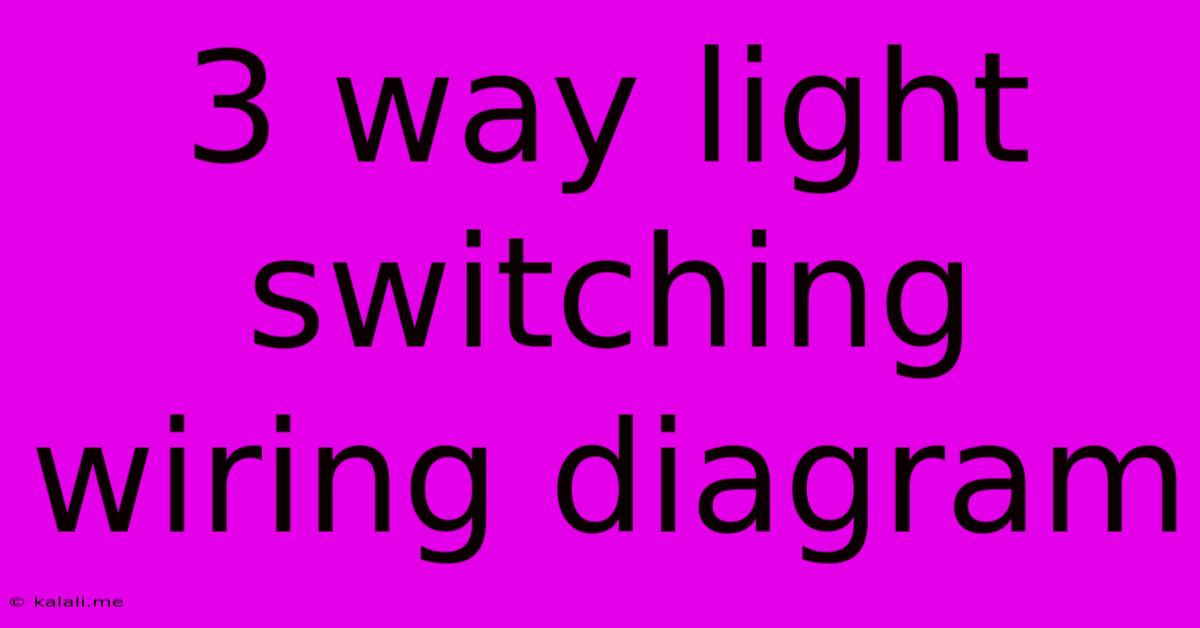3 Way Light Switching Wiring Diagram
Kalali
Jun 07, 2025 · 3 min read

Table of Contents
3-Way Light Switching Wiring Diagram: A Comprehensive Guide
This article provides a detailed explanation of 3-way light switching wiring diagrams, covering various configurations and troubleshooting tips. Understanding these diagrams is crucial for electricians and DIY enthusiasts alike, enabling safe and efficient control of lighting circuits from multiple locations. We'll break down the process step-by-step, ensuring you can confidently tackle this common home wiring project.
What is a 3-Way Switch?
A 3-way switch allows you to control a light fixture from two different locations. Unlike a standard single-pole switch, which simply completes or breaks a circuit, a 3-way switch uses a unique configuration of internal wiring and contacts to achieve this two-location control. This is particularly useful in hallways, staircases, or large rooms where controlling the light from multiple points is both convenient and practical.
Understanding the Components:
Before diving into the diagrams, let's identify the key components:
- Light Fixture: The lamp or lighting unit you want to control.
- 3-Way Switches: Two identical switches, each with three terminals (common, traveler 1, and traveler 2). These are specifically designed for multi-location switching.
- Power Source: The electrical supply feeding the circuit.
- Wires: Typically black (hot), white (neutral), and bare copper (ground).
Wiring Diagrams for a Standard 3-Way Switch Setup:
There are several ways to wire a 3-way switch setup, but the most common configuration involves the following connections:
Diagram 1: Basic 3-Way Switch Wiring
This diagram depicts the most straightforward 3-way switch installation:
[Power Source] --(Black Wire)--> [Switch 1: Common Terminal]
[Switch 1: Traveler 1 Terminal] --(Black Wire)--> [Switch 2: Traveler 1 Terminal]
[Switch 1: Traveler 2 Terminal] --(Black Wire)--> [Switch 2: Traveler 2 Terminal]
[Switch 2: Common Terminal] --(Black Wire)--> [Light Fixture]
[Light Fixture] --(White Wire)--> [Neutral Wire from Power Source]
[Ground Wire Connections (Bare Copper)]
Explanation:
- Power Source: The black (hot) wire from your power source connects to the common terminal of one of the 3-way switches.
- Traveler Wires: The traveler wires (black) connect the two 3-way switches together. These wires carry the power between the switches. It's crucial that these connections are consistent across both switches.
- Light Fixture: The common terminal of the second 3-way switch connects to the light fixture.
- Neutral and Ground: The white (neutral) wire connects directly to the light fixture and back to the neutral wire from the power source. The bare copper ground wires should be connected appropriately at both the power source and the light fixture.
Diagram 2: 3-Way Switch with Intermediate Switch
In some cases, you might need to add an intermediate switch to control the light from an additional location. This adds a level of complexity but retains the same core principles. This setup requires special intermediate switches.
This diagram is more complex and requires specialized knowledge and should only be attempted by qualified electricians.
Troubleshooting Common Problems:
- Light doesn't work from either switch: Check all wire connections for tightness and correct polarity. Ensure that the power is off before inspecting the wiring.
- Light only works from one switch: Verify the traveler wire connections between the switches. A loose or incorrect connection can prevent the light from functioning correctly.
- Light flickers or intermittently works: This could indicate a loose connection or a faulty switch. Inspect all wiring and components carefully.
Safety Precautions:
- Always turn off the power at the breaker box before working with any electrical wiring.
- Use appropriate electrical tools and safety equipment.
- If you are unsure about any aspect of this process, consult a qualified electrician.
This comprehensive guide provides a foundation for understanding and implementing 3-way light switching. Remember to prioritize safety and consult a professional if needed. With careful attention to detail, you can successfully install and troubleshoot your 3-way switch system.
Latest Posts
Latest Posts
-
Do Study Bibles Have All The Bible Verses
Jun 07, 2025
-
Can A Hot Water Heater Explode
Jun 07, 2025
-
How To Remove Pavers From A Walkway
Jun 07, 2025
-
On A Wall Power Brick Which Is Hot
Jun 07, 2025
-
How To Turn Off Imessage For One Person
Jun 07, 2025
Related Post
Thank you for visiting our website which covers about 3 Way Light Switching Wiring Diagram . We hope the information provided has been useful to you. Feel free to contact us if you have any questions or need further assistance. See you next time and don't miss to bookmark.